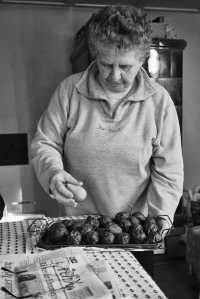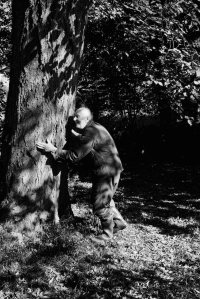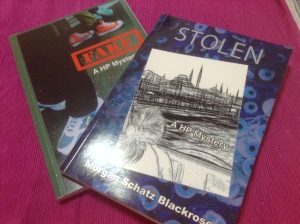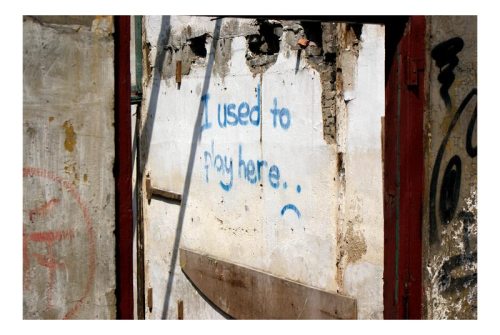Although the Palace des Nations or the ‘United Nations’ in English, is in Geneva, Switzerland, it is on UN land, and therefore is a region unto itself. In 1919, at the end of World War 1, Switzerland, because it was a neutral country, was chosen as the site for the UN’s forerunner, the League of Nations. The UN continued the League’s work and philosophy of promoting peace and disarmament with its inauguration in 1945, at the end of WW2, and occupies the original League of Nations building.
It is a remarkable organisation and the buildings and grounds and their respective artworks reflect the ideals and stories of the organisation. I felt privileged to enter the room where world peace, disarmament and human rights are discussed and determined. I would rather stand here, in the room where words of peace are forged into action, than on any ground where acts of war are written in blood. On the eve of Armistice Day, November 11, when many nations remember their war dead, I am acutely aware that the United Nations is as important now, as it ever was, in securing world peace.
Our tour guide was a passionate and knowledgeable UN worker, fluent in at least three languages, and the group was was comprised of a host of people from different nations. I was able to enjoy spotting the cultural stereotypes in our group and sharing the humour of the experience with my husband and daughter who I travel with.
There were two Indian men who asked the guide complex questions at every stop along the way, a Middle Eastern Woman constantly coddling her bored son, a Chinese man who kept videoing, after being told to stop, a Japanese student photographing the cloak room, the stairs and anything else that came into view, two Northern Europeans complete with back packs, just in case we were locked in overnight. But there were no Swiss on our tour, and we discovered none of the Swiss we knew had ever been to the Palace des Nations. I put this down to Switzerland only joining the UN in 2002 and the fact that you don’t need walking sticks to go there. The Swiss would rather spend their time climbing mountains. Or is that another cultural stereotype?
I had my picture taken with one of the few flags I am happy to wave; the UN flag, and looked forward to posting it with an accompanying write-up. But that was not to be so.
After a day of storytelling at an International school in Geneva, the next day, our family met up at the train station for the five hour return journey to the German speaking part of Switzerland. Then one of our backpacks was stolen.
With all the gear to choose from: Mama Bear’s instrument of mass entertainment, the mandolin, her bag of Australian puppets and ribbons, Baby Bear’s pack with her homework in it and Papa Bear’s pack with ipad and cameras, the one chosen by our lightning thief was not the one with a platypus in it, or homework.
We were all in a state of shock! After that we boarded the train and the following process took place: ‘If only I … ‘ ‘bastards …’ ‘organized crime …’ ‘What have we learned?’ ‘We are lucky, we have each other and all we have had stolen are things, not our homes, our homelands, or our lives.’ Later; ‘it’s not your fault.’
Revenge was a feeling expressed by our daughter. She wanted all the things that had been stolen to hurt the thief. Vengeance! Punishment! Understandable thoughts from a victim’s perspective, but are they effective as a deterrent to future criminal acts? I remembered our visit to the UN and the discussion about the punitive measures imposed on Germany after World War 1 as a causal factor of the second world war? What role does vengeance play in the perpetuation of conflict? What would the UN do to address a nation who perpetrated a criminal act on another?
In our situation we didn’t see the thief/thieves, but have it on good authority that they are members of an organised criminal group of a specific cultural identity, operating in the area.
When a violation of a person’s person or property takes place and the nationality or culture is known of the perpetrator, generalizations are often made by others. These beliefs may be adopted wholeheartedly: All Bombalasiens are thieves, all Punvarion men are sleazy, all Gungalese are lazy. However, it is very rare for qualities to be generalized and wholeheartedly adopted by others. All Pelintians are good cooks, all Thepils are great hosts, the Umpwils are a gentle people. For every generalization there is a specific incident to challenge it. Some people rationalise their prejudices with ‘I’m talking about the ones from the North, the South, who moved to our country, who come by …’
When my eldest daughter was in high school, it was pointed out to her that her name was German and Hitler was German and he was a Nazi and Germans are Nazis, and therefore she was a Nazi. Ludicrous reasoning, to be dismissed by any intelligent human being. However, racist, intolerant and ignorant human beings embrace such propaganda, and their misinformed and often hateful ideas can infect others. Immediate action must be taken to address the perniciousness of racism and bigotry so that we do not perpetuate a climate where hate crimes thrive.
And what if there is a recognized problem with particular cultures and criminal activities? For a start we can’t say that all 20 million, 100 million, 1 billion, people of that same nation or culture as the perpetrator, are the same as the perpetrator. Generalizing on our own experience is as bad as generalizing on the experience of others.
I remember my father’s hatred of a particular race of people because his father had gone to war in 1914, and fought against them, in their country. A sixteen year old illiterate boy from Australia going to a war he knew nothing about in a country he knew nothing about. Returning to Australia with his stories to tell to his children, who in turn told them to their children. My father had never met a representative of the culture he so maligned, but spoke with authority because he believed his father’s truths. In the same way we can pass on our culture, we can propagate a cultural mythology.
In telling people about the theft of our backpack we have encountered both blame for allowing it to happen by not being more vigilant, and outrage that has taken the form of justifying the call for border control, stopping immigration and other xenophobic responses, because of the association of particular races and crime. But the answer is not one of exclusion, gated communities, stronger borders, not trusting anyone. In fact it is the opposite.
We need to be more openly human and have empathy and compassion for others. If we want to prevent crime we must prevent poverty and the circumstances that push people into becoming criminals. We must educate ourselves about the perspective of others and the choices they perceive they have. This does not mean we condone criminal behaviour, but the most effective way to fight crime is with compassion.
We must help people to become the best human beings they can be, by enabling them to live a productive life, utilising all their skills and knowledge. Quality education, housing and employment for everyone in homelands that are not beseiged by war and famine is everyone’s right. Quite simply, each one of us must embody the principles of the Declaration of Human Rights and represent the philosophy of the United Nations in our lives.
Our world view has offered us comfort and a rationalisation for what has happened, and now the process of rebuilding takes place; replacing what was stolen. After all, a photographer needs a camera to be a photographer. But I’m lucky, as I’m a storyteller, and a story is all I need. Now I have one.
Photo (taken with old camera) Peace by Roman W Schatz










